Accounting Project: Financial Statement Analysis and AASB 138/IAS 38
VerifiedAdded on 2023/03/17
|8
|3003
|82
Report
AI Summary
This accounting report examines the application of AASB 138/IAS 38 to the intangible assets of Technology Enterprise Ltd. The report begins with an executive summary, followed by an introduction emphasizing the importance of accounting standards in treating intangible assets, particularly in research and development. The analysis covers the financial statement of the accounting project using net present value, and the definition of intangible assets according to IASB 138/IAS 38. The report details asset recognition, measurement, and the treatment of research costs and asset development, highlighting the company's expenditure of $1,000,000. It discusses the reduction of financial statement comparability due to intangible asset valuation, and concludes with an understanding of AASB 138/IAS 38, emphasizing its role in accounting for intangible assets and providing guidelines for companies listed on the Australian Stock Exchange. The report references key paragraphs within the standards and provides insights into the company's financial practices.
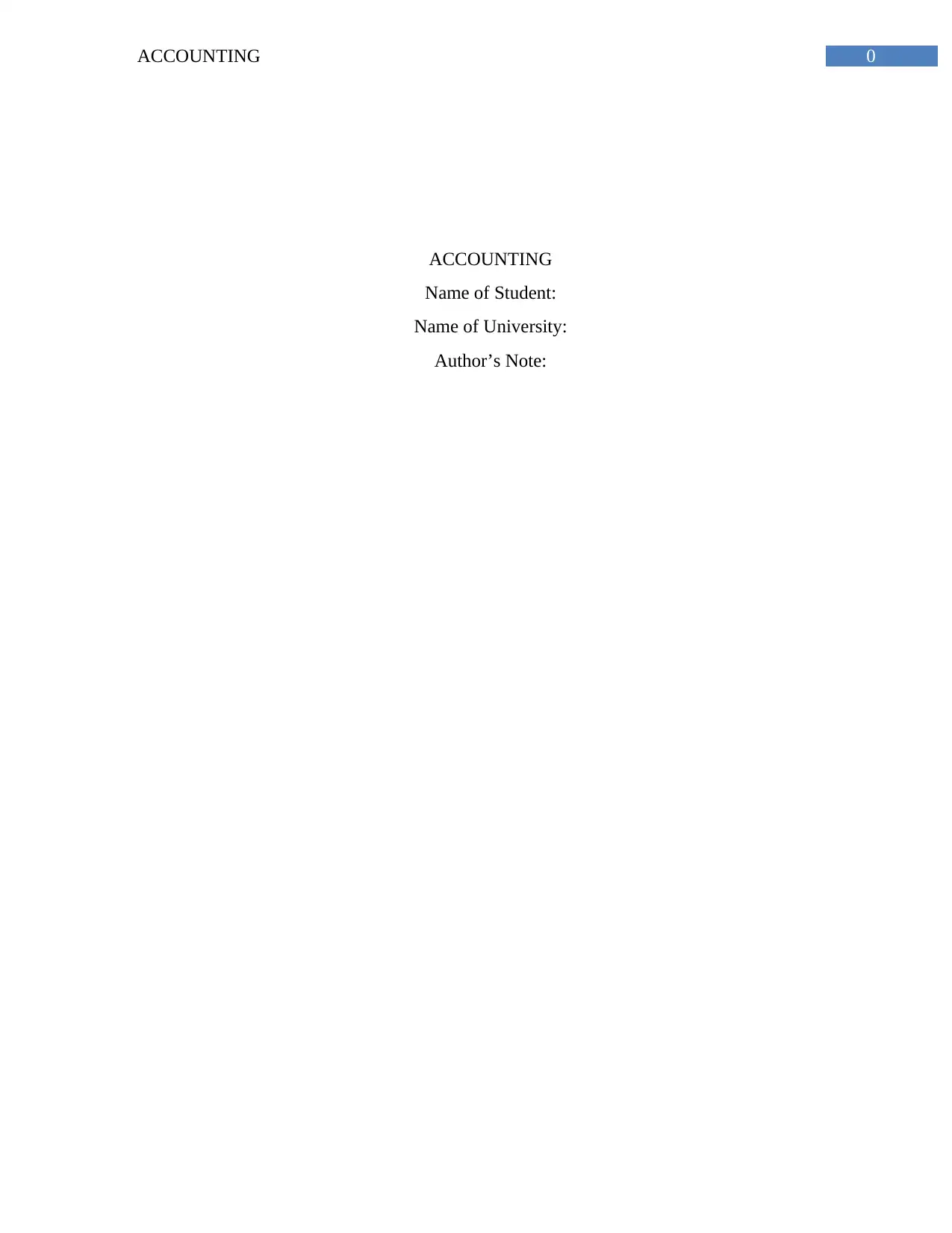
0ACCOUNTING
ACCOUNTING
Name of Student:
Name of University:
Author’s Note:
ACCOUNTING
Name of Student:
Name of University:
Author’s Note:
Paraphrase This Document
Need a fresh take? Get an instant paraphrase of this document with our AI Paraphraser
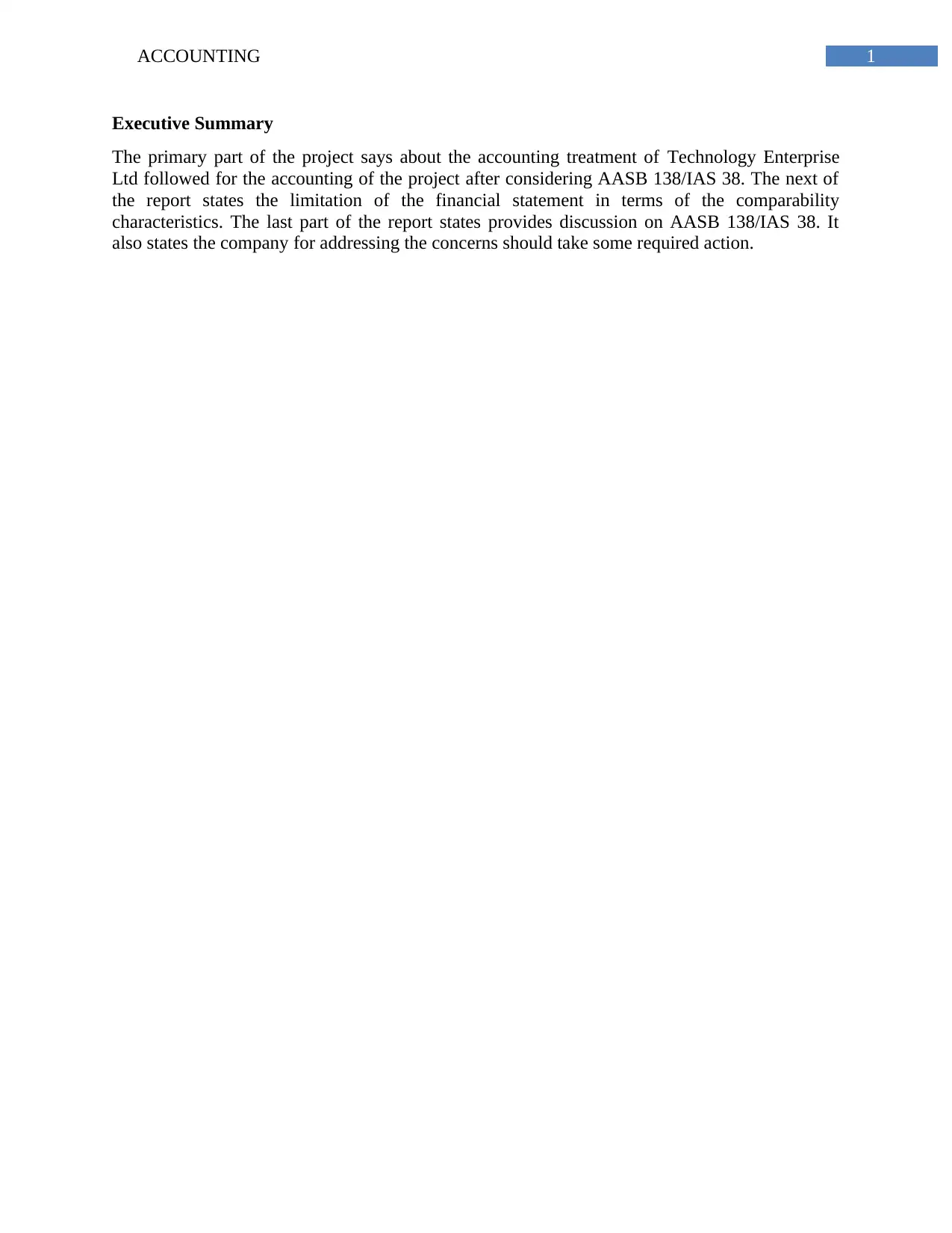
1ACCOUNTING
Executive Summary
The primary part of the project says about the accounting treatment of Technology Enterprise
Ltd followed for the accounting of the project after considering AASB 138/IAS 38. The next of
the report states the limitation of the financial statement in terms of the comparability
characteristics. The last part of the report states provides discussion on AASB 138/IAS 38. It
also states the company for addressing the concerns should take some required action.
Executive Summary
The primary part of the project says about the accounting treatment of Technology Enterprise
Ltd followed for the accounting of the project after considering AASB 138/IAS 38. The next of
the report states the limitation of the financial statement in terms of the comparability
characteristics. The last part of the report states provides discussion on AASB 138/IAS 38. It
also states the company for addressing the concerns should take some required action.
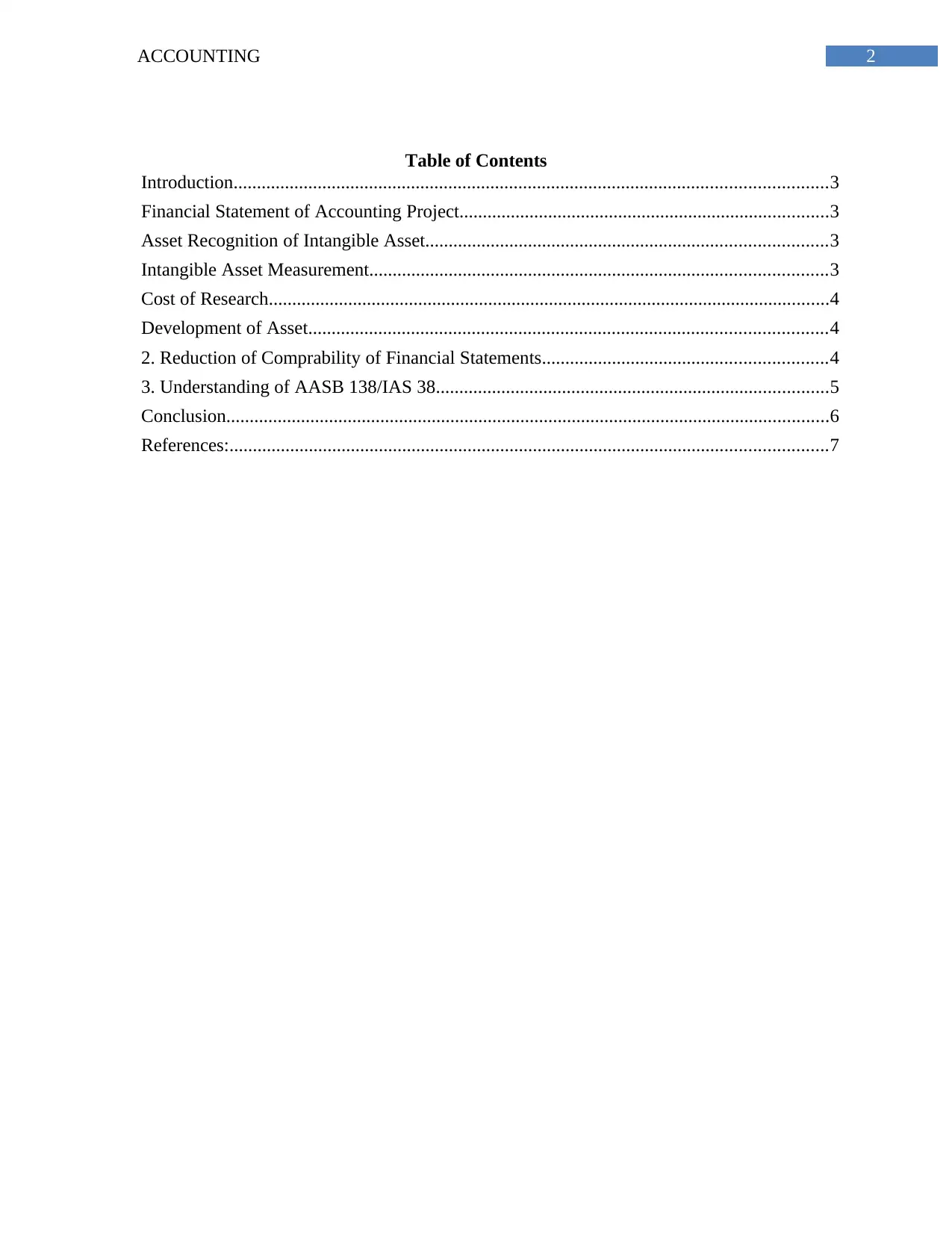
2ACCOUNTING
Table of Contents
Introduction...............................................................................................................................3
Financial Statement of Accounting Project...............................................................................3
Asset Recognition of Intangible Asset......................................................................................3
Intangible Asset Measurement..................................................................................................3
Cost of Research........................................................................................................................4
Development of Asset...............................................................................................................4
2. Reduction of Comprability of Financial Statements.............................................................4
3. Understanding of AASB 138/IAS 38....................................................................................5
Conclusion.................................................................................................................................6
References:................................................................................................................................7
Table of Contents
Introduction...............................................................................................................................3
Financial Statement of Accounting Project...............................................................................3
Asset Recognition of Intangible Asset......................................................................................3
Intangible Asset Measurement..................................................................................................3
Cost of Research........................................................................................................................4
Development of Asset...............................................................................................................4
2. Reduction of Comprability of Financial Statements.............................................................4
3. Understanding of AASB 138/IAS 38....................................................................................5
Conclusion.................................................................................................................................6
References:................................................................................................................................7
⊘ This is a preview!⊘
Do you want full access?
Subscribe today to unlock all pages.

Trusted by 1+ million students worldwide
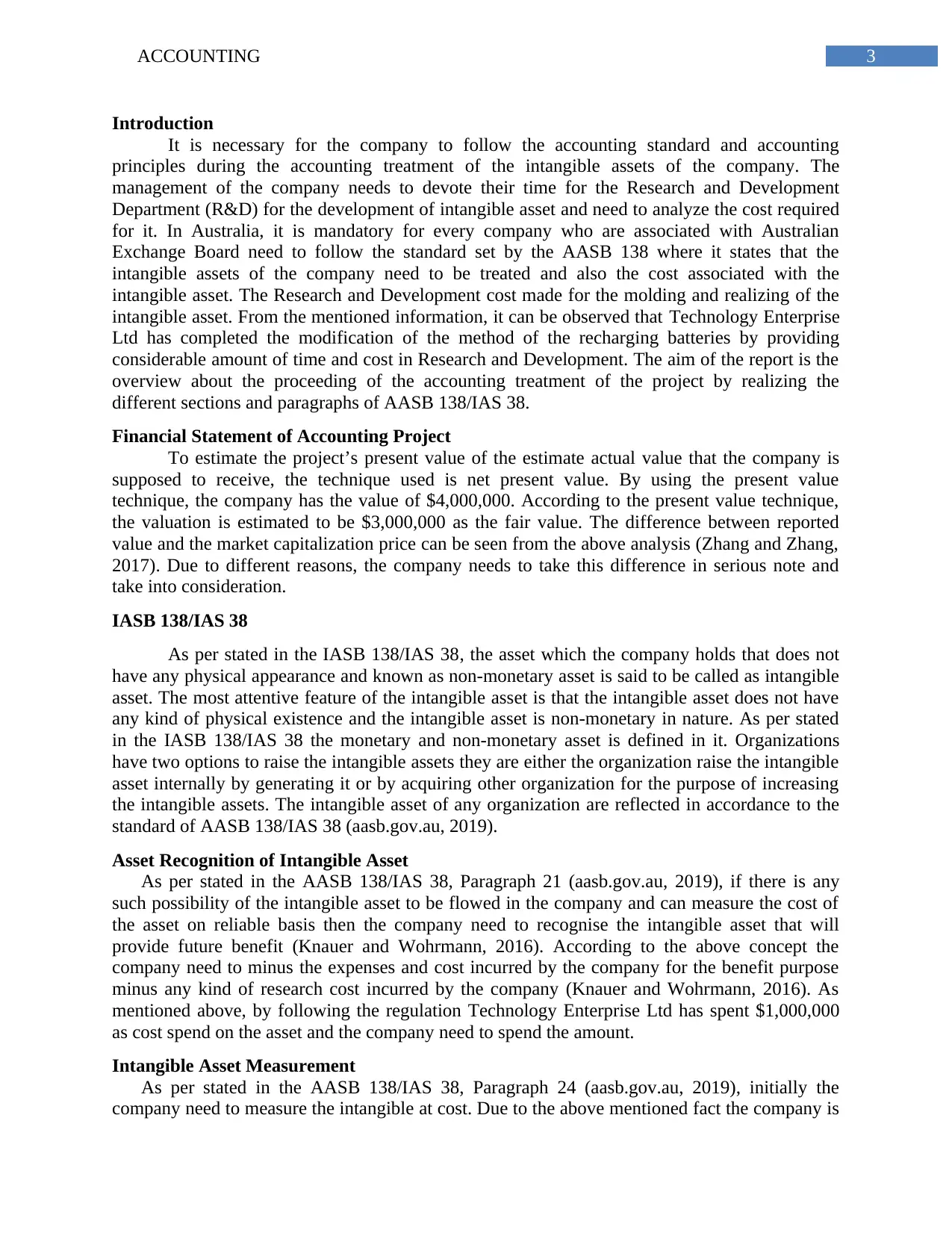
3ACCOUNTING
Introduction
It is necessary for the company to follow the accounting standard and accounting
principles during the accounting treatment of the intangible assets of the company. The
management of the company needs to devote their time for the Research and Development
Department (R&D) for the development of intangible asset and need to analyze the cost required
for it. In Australia, it is mandatory for every company who are associated with Australian
Exchange Board need to follow the standard set by the AASB 138 where it states that the
intangible assets of the company need to be treated and also the cost associated with the
intangible asset. The Research and Development cost made for the molding and realizing of the
intangible asset. From the mentioned information, it can be observed that Technology Enterprise
Ltd has completed the modification of the method of the recharging batteries by providing
considerable amount of time and cost in Research and Development. The aim of the report is the
overview about the proceeding of the accounting treatment of the project by realizing the
different sections and paragraphs of AASB 138/IAS 38.
Financial Statement of Accounting Project
To estimate the project’s present value of the estimate actual value that the company is
supposed to receive, the technique used is net present value. By using the present value
technique, the company has the value of $4,000,000. According to the present value technique,
the valuation is estimated to be $3,000,000 as the fair value. The difference between reported
value and the market capitalization price can be seen from the above analysis (Zhang and Zhang,
2017). Due to different reasons, the company needs to take this difference in serious note and
take into consideration.
IASB 138/IAS 38
As per stated in the IASB 138/IAS 38, the asset which the company holds that does not
have any physical appearance and known as non-monetary asset is said to be called as intangible
asset. The most attentive feature of the intangible asset is that the intangible asset does not have
any kind of physical existence and the intangible asset is non-monetary in nature. As per stated
in the IASB 138/IAS 38 the monetary and non-monetary asset is defined in it. Organizations
have two options to raise the intangible assets they are either the organization raise the intangible
asset internally by generating it or by acquiring other organization for the purpose of increasing
the intangible assets. The intangible asset of any organization are reflected in accordance to the
standard of AASB 138/IAS 38 (aasb.gov.au, 2019).
Asset Recognition of Intangible Asset
As per stated in the AASB 138/IAS 38, Paragraph 21 (aasb.gov.au, 2019), if there is any
such possibility of the intangible asset to be flowed in the company and can measure the cost of
the asset on reliable basis then the company need to recognise the intangible asset that will
provide future benefit (Knauer and Wohrmann, 2016). According to the above concept the
company need to minus the expenses and cost incurred by the company for the benefit purpose
minus any kind of research cost incurred by the company (Knauer and Wohrmann, 2016). As
mentioned above, by following the regulation Technology Enterprise Ltd has spent $1,000,000
as cost spend on the asset and the company need to spend the amount.
Intangible Asset Measurement
As per stated in the AASB 138/IAS 38, Paragraph 24 (aasb.gov.au, 2019), initially the
company need to measure the intangible at cost. Due to the above mentioned fact the company is
Introduction
It is necessary for the company to follow the accounting standard and accounting
principles during the accounting treatment of the intangible assets of the company. The
management of the company needs to devote their time for the Research and Development
Department (R&D) for the development of intangible asset and need to analyze the cost required
for it. In Australia, it is mandatory for every company who are associated with Australian
Exchange Board need to follow the standard set by the AASB 138 where it states that the
intangible assets of the company need to be treated and also the cost associated with the
intangible asset. The Research and Development cost made for the molding and realizing of the
intangible asset. From the mentioned information, it can be observed that Technology Enterprise
Ltd has completed the modification of the method of the recharging batteries by providing
considerable amount of time and cost in Research and Development. The aim of the report is the
overview about the proceeding of the accounting treatment of the project by realizing the
different sections and paragraphs of AASB 138/IAS 38.
Financial Statement of Accounting Project
To estimate the project’s present value of the estimate actual value that the company is
supposed to receive, the technique used is net present value. By using the present value
technique, the company has the value of $4,000,000. According to the present value technique,
the valuation is estimated to be $3,000,000 as the fair value. The difference between reported
value and the market capitalization price can be seen from the above analysis (Zhang and Zhang,
2017). Due to different reasons, the company needs to take this difference in serious note and
take into consideration.
IASB 138/IAS 38
As per stated in the IASB 138/IAS 38, the asset which the company holds that does not
have any physical appearance and known as non-monetary asset is said to be called as intangible
asset. The most attentive feature of the intangible asset is that the intangible asset does not have
any kind of physical existence and the intangible asset is non-monetary in nature. As per stated
in the IASB 138/IAS 38 the monetary and non-monetary asset is defined in it. Organizations
have two options to raise the intangible assets they are either the organization raise the intangible
asset internally by generating it or by acquiring other organization for the purpose of increasing
the intangible assets. The intangible asset of any organization are reflected in accordance to the
standard of AASB 138/IAS 38 (aasb.gov.au, 2019).
Asset Recognition of Intangible Asset
As per stated in the AASB 138/IAS 38, Paragraph 21 (aasb.gov.au, 2019), if there is any
such possibility of the intangible asset to be flowed in the company and can measure the cost of
the asset on reliable basis then the company need to recognise the intangible asset that will
provide future benefit (Knauer and Wohrmann, 2016). According to the above concept the
company need to minus the expenses and cost incurred by the company for the benefit purpose
minus any kind of research cost incurred by the company (Knauer and Wohrmann, 2016). As
mentioned above, by following the regulation Technology Enterprise Ltd has spent $1,000,000
as cost spend on the asset and the company need to spend the amount.
Intangible Asset Measurement
As per stated in the AASB 138/IAS 38, Paragraph 24 (aasb.gov.au, 2019), initially the
company need to measure the intangible at cost. Due to the above mentioned fact the company is
Paraphrase This Document
Need a fresh take? Get an instant paraphrase of this document with our AI Paraphraser
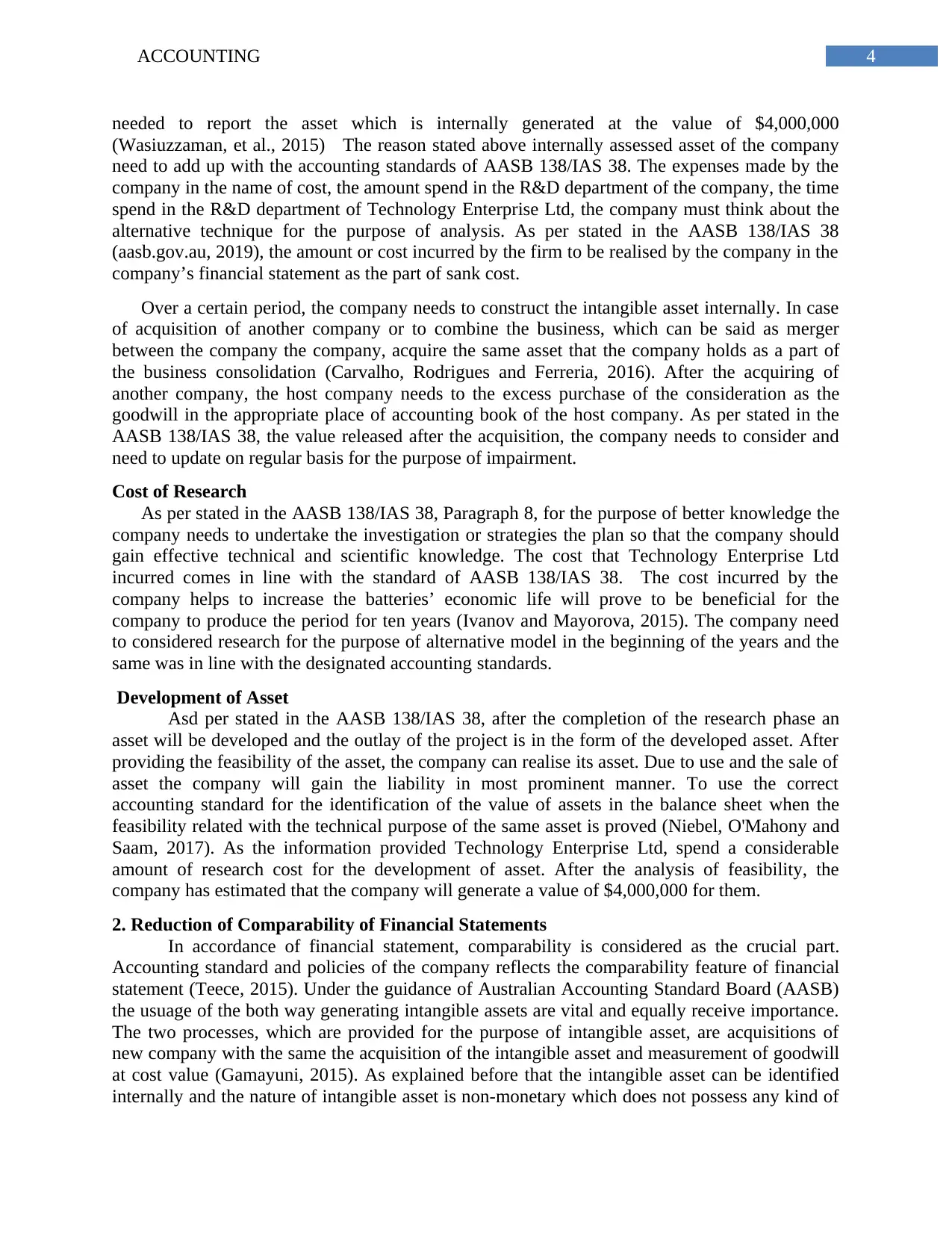
4ACCOUNTING
needed to report the asset which is internally generated at the value of $4,000,000
(Wasiuzzaman, et al., 2015) The reason stated above internally assessed asset of the company
need to add up with the accounting standards of AASB 138/IAS 38. The expenses made by the
company in the name of cost, the amount spend in the R&D department of the company, the time
spend in the R&D department of Technology Enterprise Ltd, the company must think about the
alternative technique for the purpose of analysis. As per stated in the AASB 138/IAS 38
(aasb.gov.au, 2019), the amount or cost incurred by the firm to be realised by the company in the
company’s financial statement as the part of sank cost.
Over a certain period, the company needs to construct the intangible asset internally. In case
of acquisition of another company or to combine the business, which can be said as merger
between the company the company, acquire the same asset that the company holds as a part of
the business consolidation (Carvalho, Rodrigues and Ferreria, 2016). After the acquiring of
another company, the host company needs to the excess purchase of the consideration as the
goodwill in the appropriate place of accounting book of the host company. As per stated in the
AASB 138/IAS 38, the value released after the acquisition, the company needs to consider and
need to update on regular basis for the purpose of impairment.
Cost of Research
As per stated in the AASB 138/IAS 38, Paragraph 8, for the purpose of better knowledge the
company needs to undertake the investigation or strategies the plan so that the company should
gain effective technical and scientific knowledge. The cost that Technology Enterprise Ltd
incurred comes in line with the standard of AASB 138/IAS 38. The cost incurred by the
company helps to increase the batteries’ economic life will prove to be beneficial for the
company to produce the period for ten years (Ivanov and Mayorova, 2015). The company need
to considered research for the purpose of alternative model in the beginning of the years and the
same was in line with the designated accounting standards.
Development of Asset
Asd per stated in the AASB 138/IAS 38, after the completion of the research phase an
asset will be developed and the outlay of the project is in the form of the developed asset. After
providing the feasibility of the asset, the company can realise its asset. Due to use and the sale of
asset the company will gain the liability in most prominent manner. To use the correct
accounting standard for the identification of the value of assets in the balance sheet when the
feasibility related with the technical purpose of the same asset is proved (Niebel, O'Mahony and
Saam, 2017). As the information provided Technology Enterprise Ltd, spend a considerable
amount of research cost for the development of asset. After the analysis of feasibility, the
company has estimated that the company will generate a value of $4,000,000 for them.
2. Reduction of Comparability of Financial Statements
In accordance of financial statement, comparability is considered as the crucial part.
Accounting standard and policies of the company reflects the comparability feature of financial
statement (Teece, 2015). Under the guidance of Australian Accounting Standard Board (AASB)
the usuage of the both way generating intangible assets are vital and equally receive importance.
The two processes, which are provided for the purpose of intangible asset, are acquisitions of
new company with the same the acquisition of the intangible asset and measurement of goodwill
at cost value (Gamayuni, 2015). As explained before that the intangible asset can be identified
internally and the nature of intangible asset is non-monetary which does not possess any kind of
needed to report the asset which is internally generated at the value of $4,000,000
(Wasiuzzaman, et al., 2015) The reason stated above internally assessed asset of the company
need to add up with the accounting standards of AASB 138/IAS 38. The expenses made by the
company in the name of cost, the amount spend in the R&D department of the company, the time
spend in the R&D department of Technology Enterprise Ltd, the company must think about the
alternative technique for the purpose of analysis. As per stated in the AASB 138/IAS 38
(aasb.gov.au, 2019), the amount or cost incurred by the firm to be realised by the company in the
company’s financial statement as the part of sank cost.
Over a certain period, the company needs to construct the intangible asset internally. In case
of acquisition of another company or to combine the business, which can be said as merger
between the company the company, acquire the same asset that the company holds as a part of
the business consolidation (Carvalho, Rodrigues and Ferreria, 2016). After the acquiring of
another company, the host company needs to the excess purchase of the consideration as the
goodwill in the appropriate place of accounting book of the host company. As per stated in the
AASB 138/IAS 38, the value released after the acquisition, the company needs to consider and
need to update on regular basis for the purpose of impairment.
Cost of Research
As per stated in the AASB 138/IAS 38, Paragraph 8, for the purpose of better knowledge the
company needs to undertake the investigation or strategies the plan so that the company should
gain effective technical and scientific knowledge. The cost that Technology Enterprise Ltd
incurred comes in line with the standard of AASB 138/IAS 38. The cost incurred by the
company helps to increase the batteries’ economic life will prove to be beneficial for the
company to produce the period for ten years (Ivanov and Mayorova, 2015). The company need
to considered research for the purpose of alternative model in the beginning of the years and the
same was in line with the designated accounting standards.
Development of Asset
Asd per stated in the AASB 138/IAS 38, after the completion of the research phase an
asset will be developed and the outlay of the project is in the form of the developed asset. After
providing the feasibility of the asset, the company can realise its asset. Due to use and the sale of
asset the company will gain the liability in most prominent manner. To use the correct
accounting standard for the identification of the value of assets in the balance sheet when the
feasibility related with the technical purpose of the same asset is proved (Niebel, O'Mahony and
Saam, 2017). As the information provided Technology Enterprise Ltd, spend a considerable
amount of research cost for the development of asset. After the analysis of feasibility, the
company has estimated that the company will generate a value of $4,000,000 for them.
2. Reduction of Comparability of Financial Statements
In accordance of financial statement, comparability is considered as the crucial part.
Accounting standard and policies of the company reflects the comparability feature of financial
statement (Teece, 2015). Under the guidance of Australian Accounting Standard Board (AASB)
the usuage of the both way generating intangible assets are vital and equally receive importance.
The two processes, which are provided for the purpose of intangible asset, are acquisitions of
new company with the same the acquisition of the intangible asset and measurement of goodwill
at cost value (Gamayuni, 2015). As explained before that the intangible asset can be identified
internally and the nature of intangible asset is non-monetary which does not possess any kind of
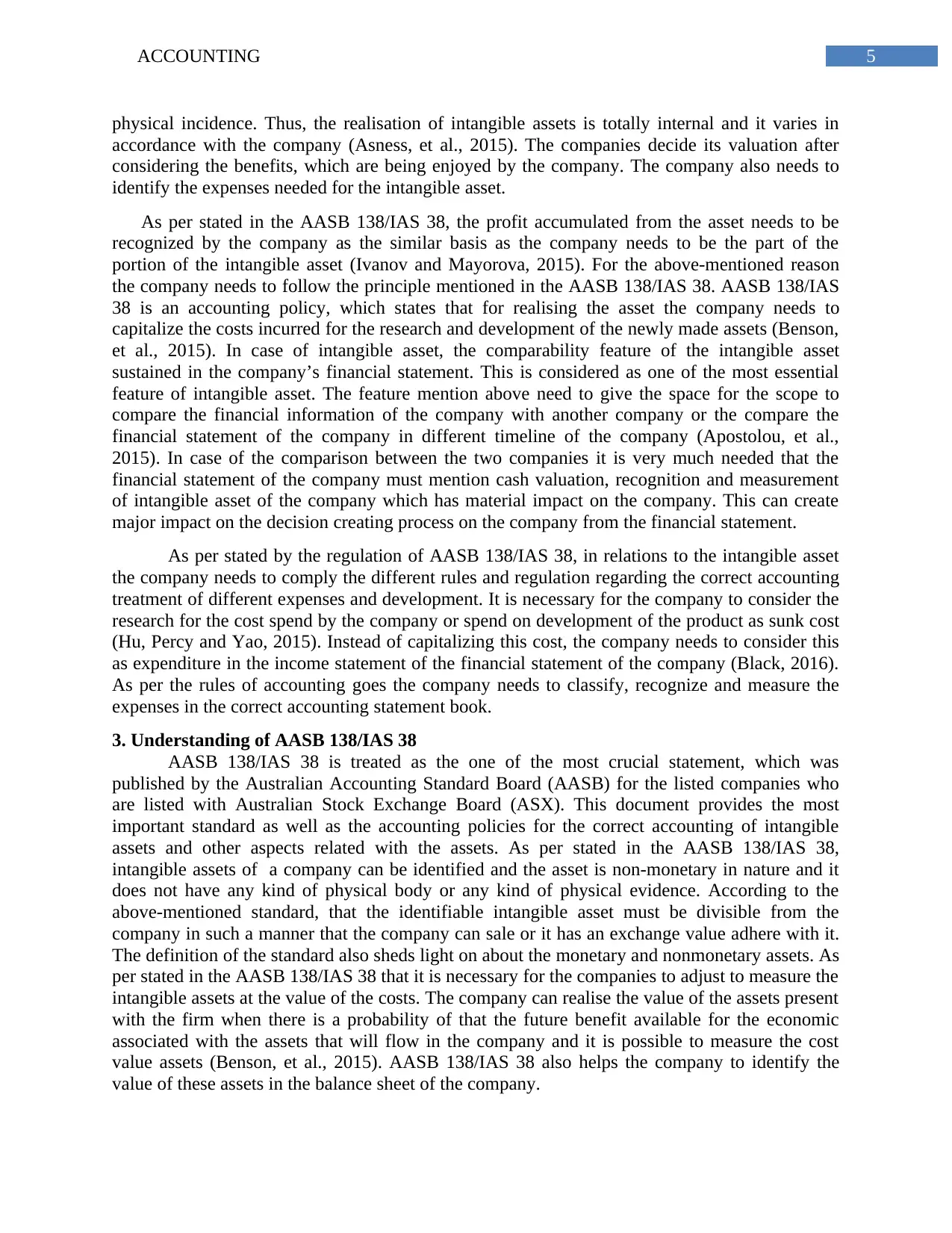
5ACCOUNTING
physical incidence. Thus, the realisation of intangible assets is totally internal and it varies in
accordance with the company (Asness, et al., 2015). The companies decide its valuation after
considering the benefits, which are being enjoyed by the company. The company also needs to
identify the expenses needed for the intangible asset.
As per stated in the AASB 138/IAS 38, the profit accumulated from the asset needs to be
recognized by the company as the similar basis as the company needs to be the part of the
portion of the intangible asset (Ivanov and Mayorova, 2015). For the above-mentioned reason
the company needs to follow the principle mentioned in the AASB 138/IAS 38. AASB 138/IAS
38 is an accounting policy, which states that for realising the asset the company needs to
capitalize the costs incurred for the research and development of the newly made assets (Benson,
et al., 2015). In case of intangible asset, the comparability feature of the intangible asset
sustained in the company’s financial statement. This is considered as one of the most essential
feature of intangible asset. The feature mention above need to give the space for the scope to
compare the financial information of the company with another company or the compare the
financial statement of the company in different timeline of the company (Apostolou, et al.,
2015). In case of the comparison between the two companies it is very much needed that the
financial statement of the company must mention cash valuation, recognition and measurement
of intangible asset of the company which has material impact on the company. This can create
major impact on the decision creating process on the company from the financial statement.
As per stated by the regulation of AASB 138/IAS 38, in relations to the intangible asset
the company needs to comply the different rules and regulation regarding the correct accounting
treatment of different expenses and development. It is necessary for the company to consider the
research for the cost spend by the company or spend on development of the product as sunk cost
(Hu, Percy and Yao, 2015). Instead of capitalizing this cost, the company needs to consider this
as expenditure in the income statement of the financial statement of the company (Black, 2016).
As per the rules of accounting goes the company needs to classify, recognize and measure the
expenses in the correct accounting statement book.
3. Understanding of AASB 138/IAS 38
AASB 138/IAS 38 is treated as the one of the most crucial statement, which was
published by the Australian Accounting Standard Board (AASB) for the listed companies who
are listed with Australian Stock Exchange Board (ASX). This document provides the most
important standard as well as the accounting policies for the correct accounting of intangible
assets and other aspects related with the assets. As per stated in the AASB 138/IAS 38,
intangible assets of a company can be identified and the asset is non-monetary in nature and it
does not have any kind of physical body or any kind of physical evidence. According to the
above-mentioned standard, that the identifiable intangible asset must be divisible from the
company in such a manner that the company can sale or it has an exchange value adhere with it.
The definition of the standard also sheds light on about the monetary and nonmonetary assets. As
per stated in the AASB 138/IAS 38 that it is necessary for the companies to adjust to measure the
intangible assets at the value of the costs. The company can realise the value of the assets present
with the firm when there is a probability of that the future benefit available for the economic
associated with the assets that will flow in the company and it is possible to measure the cost
value assets (Benson, et al., 2015). AASB 138/IAS 38 also helps the company to identify the
value of these assets in the balance sheet of the company.
physical incidence. Thus, the realisation of intangible assets is totally internal and it varies in
accordance with the company (Asness, et al., 2015). The companies decide its valuation after
considering the benefits, which are being enjoyed by the company. The company also needs to
identify the expenses needed for the intangible asset.
As per stated in the AASB 138/IAS 38, the profit accumulated from the asset needs to be
recognized by the company as the similar basis as the company needs to be the part of the
portion of the intangible asset (Ivanov and Mayorova, 2015). For the above-mentioned reason
the company needs to follow the principle mentioned in the AASB 138/IAS 38. AASB 138/IAS
38 is an accounting policy, which states that for realising the asset the company needs to
capitalize the costs incurred for the research and development of the newly made assets (Benson,
et al., 2015). In case of intangible asset, the comparability feature of the intangible asset
sustained in the company’s financial statement. This is considered as one of the most essential
feature of intangible asset. The feature mention above need to give the space for the scope to
compare the financial information of the company with another company or the compare the
financial statement of the company in different timeline of the company (Apostolou, et al.,
2015). In case of the comparison between the two companies it is very much needed that the
financial statement of the company must mention cash valuation, recognition and measurement
of intangible asset of the company which has material impact on the company. This can create
major impact on the decision creating process on the company from the financial statement.
As per stated by the regulation of AASB 138/IAS 38, in relations to the intangible asset
the company needs to comply the different rules and regulation regarding the correct accounting
treatment of different expenses and development. It is necessary for the company to consider the
research for the cost spend by the company or spend on development of the product as sunk cost
(Hu, Percy and Yao, 2015). Instead of capitalizing this cost, the company needs to consider this
as expenditure in the income statement of the financial statement of the company (Black, 2016).
As per the rules of accounting goes the company needs to classify, recognize and measure the
expenses in the correct accounting statement book.
3. Understanding of AASB 138/IAS 38
AASB 138/IAS 38 is treated as the one of the most crucial statement, which was
published by the Australian Accounting Standard Board (AASB) for the listed companies who
are listed with Australian Stock Exchange Board (ASX). This document provides the most
important standard as well as the accounting policies for the correct accounting of intangible
assets and other aspects related with the assets. As per stated in the AASB 138/IAS 38,
intangible assets of a company can be identified and the asset is non-monetary in nature and it
does not have any kind of physical body or any kind of physical evidence. According to the
above-mentioned standard, that the identifiable intangible asset must be divisible from the
company in such a manner that the company can sale or it has an exchange value adhere with it.
The definition of the standard also sheds light on about the monetary and nonmonetary assets. As
per stated in the AASB 138/IAS 38 that it is necessary for the companies to adjust to measure the
intangible assets at the value of the costs. The company can realise the value of the assets present
with the firm when there is a probability of that the future benefit available for the economic
associated with the assets that will flow in the company and it is possible to measure the cost
value assets (Benson, et al., 2015). AASB 138/IAS 38 also helps the company to identify the
value of these assets in the balance sheet of the company.
⊘ This is a preview!⊘
Do you want full access?
Subscribe today to unlock all pages.

Trusted by 1+ million students worldwide
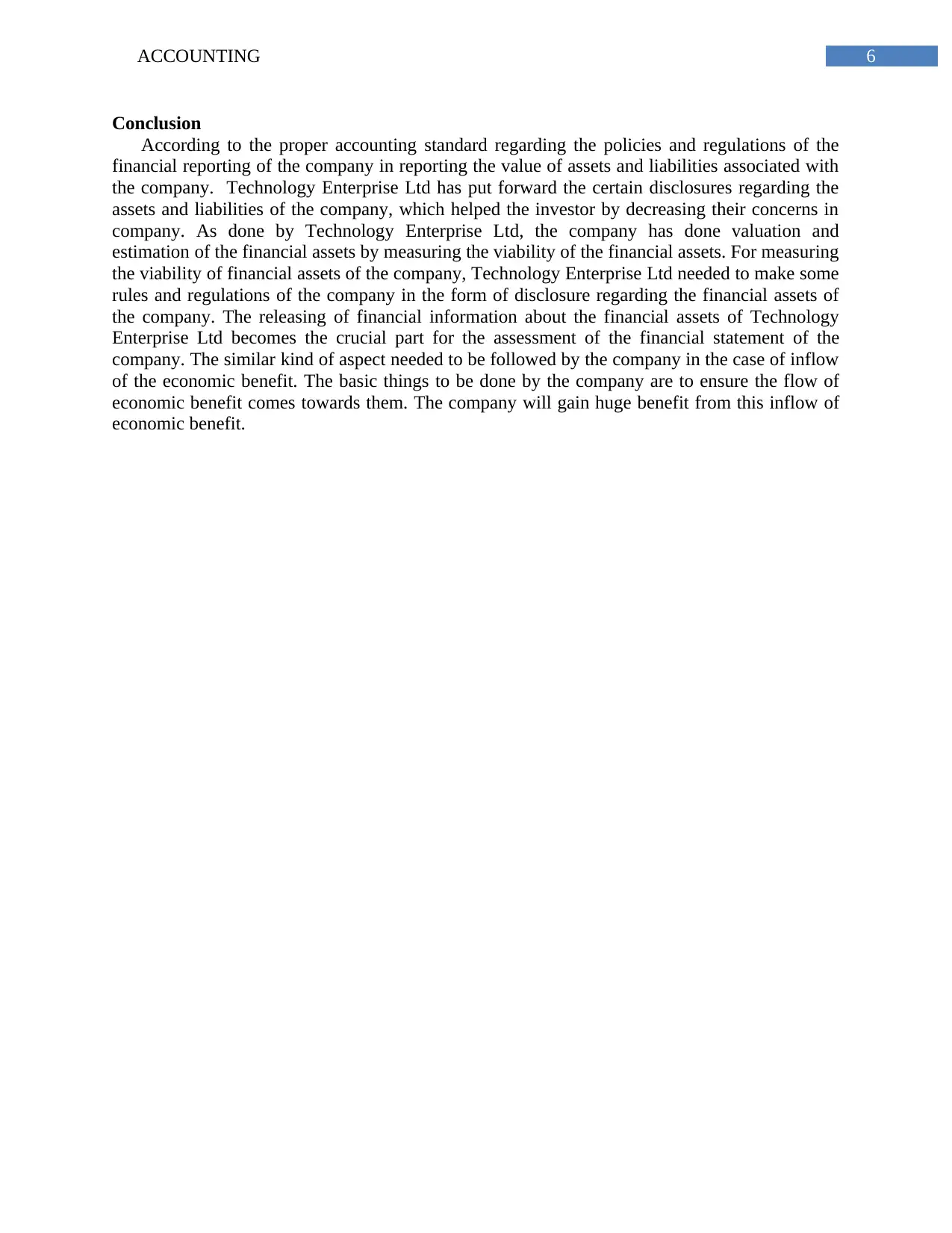
6ACCOUNTING
Conclusion
According to the proper accounting standard regarding the policies and regulations of the
financial reporting of the company in reporting the value of assets and liabilities associated with
the company. Technology Enterprise Ltd has put forward the certain disclosures regarding the
assets and liabilities of the company, which helped the investor by decreasing their concerns in
company. As done by Technology Enterprise Ltd, the company has done valuation and
estimation of the financial assets by measuring the viability of the financial assets. For measuring
the viability of financial assets of the company, Technology Enterprise Ltd needed to make some
rules and regulations of the company in the form of disclosure regarding the financial assets of
the company. The releasing of financial information about the financial assets of Technology
Enterprise Ltd becomes the crucial part for the assessment of the financial statement of the
company. The similar kind of aspect needed to be followed by the company in the case of inflow
of the economic benefit. The basic things to be done by the company are to ensure the flow of
economic benefit comes towards them. The company will gain huge benefit from this inflow of
economic benefit.
Conclusion
According to the proper accounting standard regarding the policies and regulations of the
financial reporting of the company in reporting the value of assets and liabilities associated with
the company. Technology Enterprise Ltd has put forward the certain disclosures regarding the
assets and liabilities of the company, which helped the investor by decreasing their concerns in
company. As done by Technology Enterprise Ltd, the company has done valuation and
estimation of the financial assets by measuring the viability of the financial assets. For measuring
the viability of financial assets of the company, Technology Enterprise Ltd needed to make some
rules and regulations of the company in the form of disclosure regarding the financial assets of
the company. The releasing of financial information about the financial assets of Technology
Enterprise Ltd becomes the crucial part for the assessment of the financial statement of the
company. The similar kind of aspect needed to be followed by the company in the case of inflow
of the economic benefit. The basic things to be done by the company are to ensure the flow of
economic benefit comes towards them. The company will gain huge benefit from this inflow of
economic benefit.
Paraphrase This Document
Need a fresh take? Get an instant paraphrase of this document with our AI Paraphraser
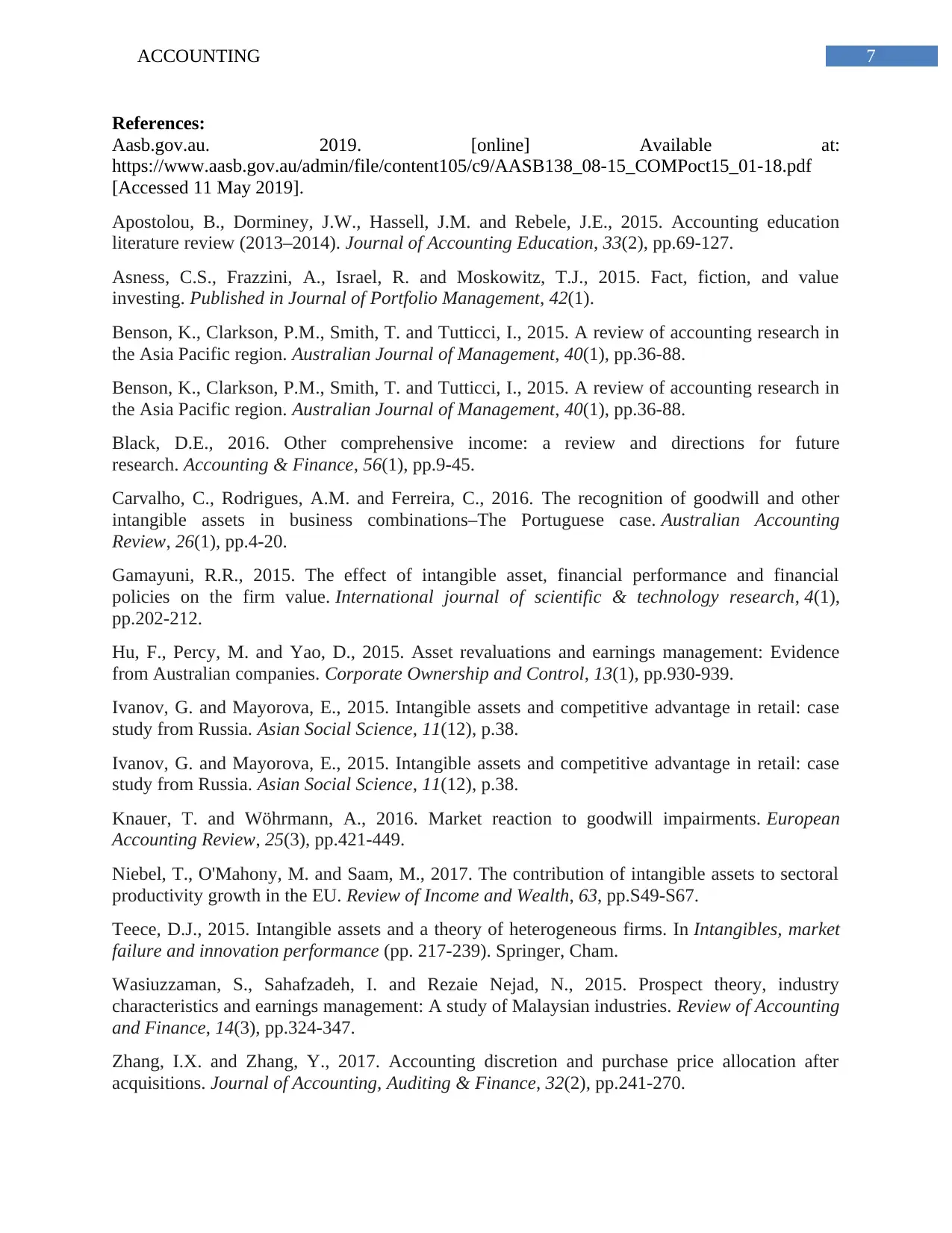
7ACCOUNTING
References:
Aasb.gov.au. 2019. [online] Available at:
https://www.aasb.gov.au/admin/file/content105/c9/AASB138_08-15_COMPoct15_01-18.pdf
[Accessed 11 May 2019].
Apostolou, B., Dorminey, J.W., Hassell, J.M. and Rebele, J.E., 2015. Accounting education
literature review (2013–2014). Journal of Accounting Education, 33(2), pp.69-127.
Asness, C.S., Frazzini, A., Israel, R. and Moskowitz, T.J., 2015. Fact, fiction, and value
investing. Published in Journal of Portfolio Management, 42(1).
Benson, K., Clarkson, P.M., Smith, T. and Tutticci, I., 2015. A review of accounting research in
the Asia Pacific region. Australian Journal of Management, 40(1), pp.36-88.
Benson, K., Clarkson, P.M., Smith, T. and Tutticci, I., 2015. A review of accounting research in
the Asia Pacific region. Australian Journal of Management, 40(1), pp.36-88.
Black, D.E., 2016. Other comprehensive income: a review and directions for future
research. Accounting & Finance, 56(1), pp.9-45.
Carvalho, C., Rodrigues, A.M. and Ferreira, C., 2016. The recognition of goodwill and other
intangible assets in business combinations–The Portuguese case. Australian Accounting
Review, 26(1), pp.4-20.
Gamayuni, R.R., 2015. The effect of intangible asset, financial performance and financial
policies on the firm value. International journal of scientific & technology research, 4(1),
pp.202-212.
Hu, F., Percy, M. and Yao, D., 2015. Asset revaluations and earnings management: Evidence
from Australian companies. Corporate Ownership and Control, 13(1), pp.930-939.
Ivanov, G. and Mayorova, E., 2015. Intangible assets and competitive advantage in retail: case
study from Russia. Asian Social Science, 11(12), p.38.
Ivanov, G. and Mayorova, E., 2015. Intangible assets and competitive advantage in retail: case
study from Russia. Asian Social Science, 11(12), p.38.
Knauer, T. and Wöhrmann, A., 2016. Market reaction to goodwill impairments. European
Accounting Review, 25(3), pp.421-449.
Niebel, T., O'Mahony, M. and Saam, M., 2017. The contribution of intangible assets to sectoral
productivity growth in the EU. Review of Income and Wealth, 63, pp.S49-S67.
Teece, D.J., 2015. Intangible assets and a theory of heterogeneous firms. In Intangibles, market
failure and innovation performance (pp. 217-239). Springer, Cham.
Wasiuzzaman, S., Sahafzadeh, I. and Rezaie Nejad, N., 2015. Prospect theory, industry
characteristics and earnings management: A study of Malaysian industries. Review of Accounting
and Finance, 14(3), pp.324-347.
Zhang, I.X. and Zhang, Y., 2017. Accounting discretion and purchase price allocation after
acquisitions. Journal of Accounting, Auditing & Finance, 32(2), pp.241-270.
References:
Aasb.gov.au. 2019. [online] Available at:
https://www.aasb.gov.au/admin/file/content105/c9/AASB138_08-15_COMPoct15_01-18.pdf
[Accessed 11 May 2019].
Apostolou, B., Dorminey, J.W., Hassell, J.M. and Rebele, J.E., 2015. Accounting education
literature review (2013–2014). Journal of Accounting Education, 33(2), pp.69-127.
Asness, C.S., Frazzini, A., Israel, R. and Moskowitz, T.J., 2015. Fact, fiction, and value
investing. Published in Journal of Portfolio Management, 42(1).
Benson, K., Clarkson, P.M., Smith, T. and Tutticci, I., 2015. A review of accounting research in
the Asia Pacific region. Australian Journal of Management, 40(1), pp.36-88.
Benson, K., Clarkson, P.M., Smith, T. and Tutticci, I., 2015. A review of accounting research in
the Asia Pacific region. Australian Journal of Management, 40(1), pp.36-88.
Black, D.E., 2016. Other comprehensive income: a review and directions for future
research. Accounting & Finance, 56(1), pp.9-45.
Carvalho, C., Rodrigues, A.M. and Ferreira, C., 2016. The recognition of goodwill and other
intangible assets in business combinations–The Portuguese case. Australian Accounting
Review, 26(1), pp.4-20.
Gamayuni, R.R., 2015. The effect of intangible asset, financial performance and financial
policies on the firm value. International journal of scientific & technology research, 4(1),
pp.202-212.
Hu, F., Percy, M. and Yao, D., 2015. Asset revaluations and earnings management: Evidence
from Australian companies. Corporate Ownership and Control, 13(1), pp.930-939.
Ivanov, G. and Mayorova, E., 2015. Intangible assets and competitive advantage in retail: case
study from Russia. Asian Social Science, 11(12), p.38.
Ivanov, G. and Mayorova, E., 2015. Intangible assets and competitive advantage in retail: case
study from Russia. Asian Social Science, 11(12), p.38.
Knauer, T. and Wöhrmann, A., 2016. Market reaction to goodwill impairments. European
Accounting Review, 25(3), pp.421-449.
Niebel, T., O'Mahony, M. and Saam, M., 2017. The contribution of intangible assets to sectoral
productivity growth in the EU. Review of Income and Wealth, 63, pp.S49-S67.
Teece, D.J., 2015. Intangible assets and a theory of heterogeneous firms. In Intangibles, market
failure and innovation performance (pp. 217-239). Springer, Cham.
Wasiuzzaman, S., Sahafzadeh, I. and Rezaie Nejad, N., 2015. Prospect theory, industry
characteristics and earnings management: A study of Malaysian industries. Review of Accounting
and Finance, 14(3), pp.324-347.
Zhang, I.X. and Zhang, Y., 2017. Accounting discretion and purchase price allocation after
acquisitions. Journal of Accounting, Auditing & Finance, 32(2), pp.241-270.
1 out of 8
Related Documents
Your All-in-One AI-Powered Toolkit for Academic Success.
+13062052269
info@desklib.com
Available 24*7 on WhatsApp / Email
![[object Object]](/_next/static/media/star-bottom.7253800d.svg)
Unlock your academic potential
Copyright © 2020–2025 A2Z Services. All Rights Reserved. Developed and managed by ZUCOL.





